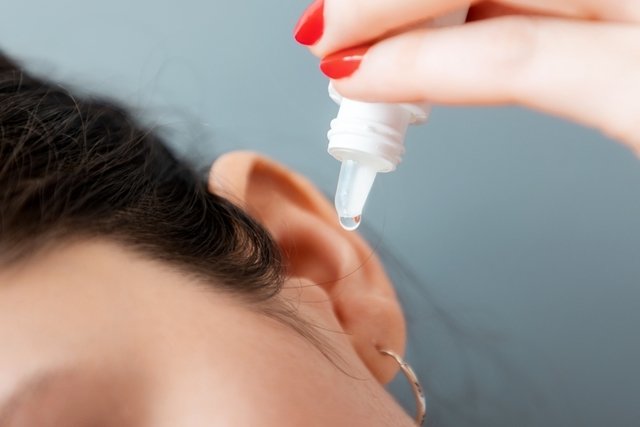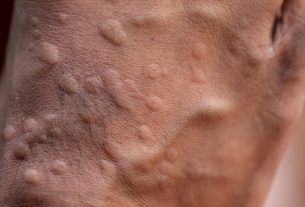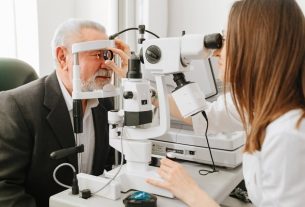One way to try to get the insect out of your ear is to tilt your head to the side of the affected ear and shake your head, or use a few drops of oil to try to kill the insect and make it easier to exit. However, if the insect does not come out, you should consult an otolaryngologist or go to the emergency room.
When an insect enters the ear it can cause a lot of discomfort, generating symptoms such as difficulty hearing, intense itching, irritation or pain. Furthermore, if the insect is alive, it can also cause ringing in the ears and loud, painful sounds due to its movement.
In all cases, you should avoid scratching your ear, as well as avoiding removing what is inside it with your finger or cotton swab, as this can push the insect further into the ear, causing damage to the ear canal. or perforation in the eardrum, and worsen symptoms.

3 ways to get the bug out of your ear
Some ways that can be used to try to get the insect out of the ear are:
1. Use a blade of grass
Grass is a very flexible material, but it has small protrusions that insects cling to. This way, it can be used at the entrance to the ear without the risk of puncturing the eardrum or pushing the insect.
To use the blade of grass, you must wash the blade with a little soap and water and then try to place it under the insect’s legs and wait a few seconds, then pull it out. If the insect grabs the leaf, it will be pulled out, but if it remains inside the ear, this process can be repeated a few times.
2. Use a few drops of oil
Oil is a great option when other attempts have not worked, as it is a way to kill the ear quickly, without the risk of being bitten or scratched inside the ear. Furthermore, as the oil lubricates the ear canal, the insect can slip out or come out more easily when you shake your head again.
To use this technique, place 2 to 3 drops of oil, such as olive oil, baby oil, almond oil or even cooking oil, inside the ear and then place your head tilted to the side of the affected ear, waiting for a few seconds. Finally, if the insect does not come out on its own, you should try shaking your head again or moving your ear.
This technique should not be used if the eardrum is ruptured or if there is a suspicion that there is a problem with the ear. Ideally, the oil should be at room temperature or slightly warm, but not hot enough to cause burns.
3. Cleanse with warm water or serum
This technique should only be used when you are sure that the insect is already dead, as using water can cause the insect to start trying to scratch or sting, causing injuries to the inside of the ear, if it is still alive.
The ideal in this case is to use a PET bottle with a hole in the lid, for example, to create a jet of water that is capable of entering the ear with some pressure and cleaning what is inside.
Step by step to get the bug out of your ear
When an insect gets into your ear, you should take some precautions to try to remove it, such as:
- Keep calmas the agitation and sudden attempt to remove the insect can make the insect enter the ear and worsen the symptoms;
- Confirm if there are any insects inside the earusing a flashlight and a magnifying glass, for example;
- Try to locate the insectwhether it is more externally in the ear or inside the ear, close to the eardrum;
- Avoid removing the insect with your finger, cotton swabs, staples or tweezersas it can push the insect deeper into the ear and cause damage.
- Pull the earlobe backin order to straighten the ear canal;
- Tilt your head to the side of the affected ear and shake your headwithout hitting, to try to get the insect to come out;
- Do one of the techniquesgrass, drops of oil or cleaning with warm water, to try to remove the insect from the ear.
After removing the insect, the ear must be inspected again to make sure that no part of the insect remains inside the ear, as it can cause infections, such as otitis, for example.
When to go to the doctor
It is advisable to go to the emergency room when the symptoms are very strong or worsen over time, as well as if the insect cannot be removed using these techniques. The doctor may use special instruments to remove the insect without causing any damage to the inside of the ear.
Furthermore, if it is not possible to observe an insect inside the ear, but there is intense discomfort, an otorhinolaryngologist should be consulted to assess the possible causes and initiate appropriate treatment, if necessary.
Taking care of your health has never been easier!
Bibliography
- CIMOLAI, N.; CIMOLAI, TL Otitis from the Common Bedbug. J Clin Aesthet Dermatol. 5. 12; 43–45, 2012
- KEKRE, M.; et al. Foreign Bodies in Ear, Nose, Throat and Maxillofacial Region: A Study on Their Clinical Profile and Complications. Indian J Otolaryngol Head Neck Surg. 74. Suppl 3; 4483-4494, 2022
- STANFORD MEDICINE CHILDREN’S HEALTH. Insects in a Child’s Ear. Disponível em: <https://www.stanfordchildrens.org/en/topic/default?id=insects-in-the-ear-90-P02828>. Acesso em 14 abr 2023




